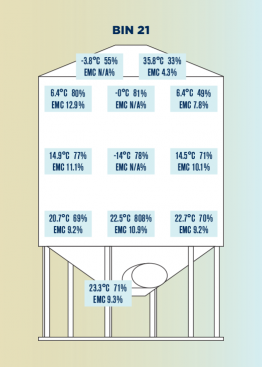Key Result
As winter transitions into summer, monitor the temperature profile in canola bins for any rapid increases that may indicate spoilage. Aerating and turning seed to warm up canola stored throughout the cold western Canadian winter is not necessary.
Project Summary
High yielding canola fields, recent challenges with railway transportation, and canola varieties producing increasingly high oil content all emphasize the need for good storage practices. This study filled a knowledge gap on what to do with canola stored through the winter and into the summer. Aerate? Turn it? Leave it? The study found that monitoring is critical for noticing sudden temperature increases, but turning or aeration is often not necessary.
The one-year study used regular, commercial-sized grain bins to measure temperature, relative humidity and airflow rates. Three different management practices — aeration, turning, leaving it alone — were implemented on three 4,000-bushel bins full of canola. Two of the bins were monitored throughout June and July, while one collected data all the way until the end of November.

Canola used in this study had very low moisture — six percent. Prior to the study period, canola had been stored over the winter and frozen.
Based on the success of this project, Agnew is seeking a continuation to test conditions in bins with larger diameter, canola with higher moisture content and potentially different winter temperatures.
RESULTS
Agnew found that despite a large temperature differential (28°C) within the bin, temperature and moisture of the grain remained fairly stable throughout the summer.
There was very little moisture migration and therefore no spoilage or condensation with the dry canola. The temperatures at the edge of the bin (25°C) were much different than the core (-3°C) throughout most of July, with
no difference between temperatures on the sunny or shady side of the bin. Bin headspace temperatures varied drastically from day to night, but the relative humidity was low (less than 40 percent) so there was very little condensation on the top layer. Due to the insulating effect of canola, the temperature of the grain in the top two feet of the bin didn’t fluctuate throughout the day.
In terms of management options, turning the seed initially resulted in more uniform temperature distribution. However, due to the fact that the grain funnels down the centre of the bin when a portion of it is removed, there were several zones of cold grain adjacent to warm grain. These zones were considered unstable and could have resulted in condensation. In addition, while aerating with warm summer air evened out the temperature distribution, the transition between warming and cool seed created unstable conditions (which could have caused some spoilage). Despite the formation of these unstable zones, neither aerating nor turning resulted in any spoilage, fortunately.
CONCLUSIONS
The results of this study of very dry canola that had been cooled to -30°C over the winter suggest that neither turning nor aerating canola minimizes summer storage risk. The best option found was to just monitor the temperature profile (watching for any rapid increases in temperature, regardless
of the actual temperature value) and have a plan to move it if this or another issue arises.
See more details at the Canola Watch blog.
For subsequent summer storage of canola research, see Determining best practices for summer storage of canola in Western Canada (part 2).





